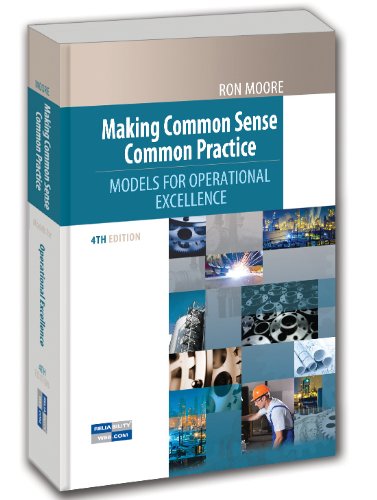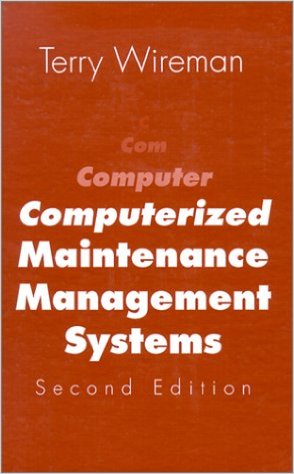
The best maintenance and reliability books
The best maintenance and reliability books. Click on a book to purchase it from Amazon.com Are you interested in taking the CMRP, CMRT or CRL exams? Are you involved in maintenance and reliability? If you answered yes to either of these questions, then these books are must reads! Ramesh Gulati, Ron Moore, Terry Wireman, Jefferey Liker, Juran, Deming, Anthony Smith, Stephen Covey
Apart from the CRL Pocket Dictionary, the books that follow are recommended reading for SMRP’s CMRP certification exam. These books are considered the Body of Knowledge making up the 5 pillars of knowledge.
 |
 |
By Ramesh GulatiRamesh is a Certified Maintenance & Reliability Professional (CMRP), Certified Reliability Engineer (CRE), and a registered Professional Engineer (PE). He holds BSME, MSIE, and MBA degrees, is very active in professional societies and has authored many professional papers. Currently, for SMRP, he serves as Certification Committee chair and was director of Certification and Standards, Best Practices, Body of Knowledge, and a Board member. He also serves as an advisory Board member for the University of Tennessee’s Reliability & Maintenance Center (RMC). He is a member of Association of Maintenance Professionals (AMP) and a Fellow of the Institute of Industrial Engineering (IIE). Recently, Ramesh served as a U.S. delegate to the ISO/PC251 committee, supporting development of a new Asset Management Standard. |
Maintenance Best Practices 2nd Edition Winner of first prize (Gold Award) in the RGVA book competition in Maintenance & Reliability at MARTS/Chicago in 2011. |
 |
 |
| Workbook to accompany Maintenance and Reliability Best Practices 2nd Edition
This softbound workbook is the ideal guide for readers of Gulati’s Maintenance and Reliability Best Practices, 2nd edition, as well as for students in a classroom or seminar/workshop setting. Each chapter provides extensive Powerpoint-style summaries of important vocabulary and essential concepts, in a format that encourages students to write additional notes and evaluations of the content. Includes reviews of chapter objectives and summaries. Provides readers with answers to the main text’s assessment exercises as well as additional questions to direct their study. Each chapter concludes with a set of independent research questions; these questions help readers expand their understanding of the content as they prepare to apply best practices. |
Certified Reliability Leader Pocket Dictionary What is a reliability leader? Anyone who helps another person, a machine or a gadget do a better job. This book represents a significant step towards improving the knowledge of, and communications between, members of the Maintenance and Reliability Profession. The compilation reflects a virtual explosion of commonly practiced concepts, ideas, methodologies and various approaches to maintenance and reliability improvements. An additional directory of maintenance and reliability acronyms is included. Maintenance and reliability involves many different people in many different roles. If we are expected to work efficiently, productively, and harmoniously on tasks and projects, there is need for a common language for communication. |
Ron Moore
|
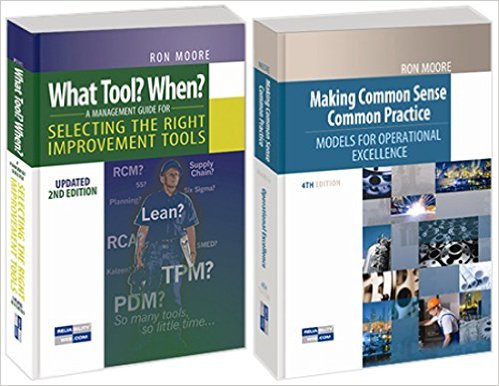 |
| Making Common Sense Common Practice
An in-depth view into the best practices of the best manufacturing companies in the world. This book presents proven models for achieving world-class performance. Using a case study of a fictional company called Beta International, Moore illustrates how to increase uptime, lower costs, increase market share, maximize asset utilization, apply benchmarks and best practices, ultimately increasing your company’s performance. Gain an expert view of plant design, procurement, parts management, installation and maintenance, training, and implementation of a computerized maintenance management system. In discussing the success and failure of the world’s premier manufacturers, Moore outlines a stable path of growth for almost any manufacturing company. In today’s tough competitive markets, this valuable information greatly enhances your company’s chance to succeed and profit. |
Making Common Sense Common Practice Bundle
Two Book Set 1) What Tool? When? – This book describes several of the more common and popular methods, including case studies, being used by manufacturing companies to improve their business. Even before we cover these tools and strategies, we cover several fundamental issues-if present, almost any tool will be effective, but if absent, almost not tool will work, i.e., the need for leadership and several models thereto for creating an environment that brings out the best in people, the need for innovation throughout the organization, including what I call big innovation- R&D and new product/process development, but also little innovation. |
 |
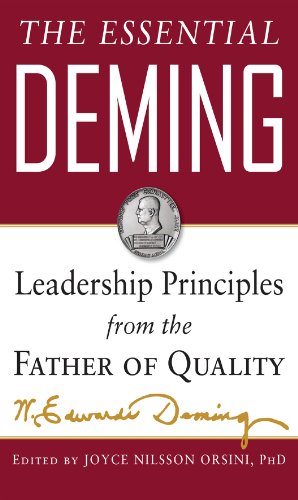 |
| Juran’s Quality Handbook
The definitive quality management compendium–revised for the first time in a decade Juran’s Quality Handbook, sixth edition covers: Leadership–what everyone needs to know about managing for superior quality and results |
The Essential Deming: Leadership Principles from the Father of Quality The name W. Edwards Deming is synonymous with the most insightful views, ideas, and commentary on management and quality control. Referred to as “the high prophet of quality” by the New York Times, Deming was instrumental in the spectacular rise of Japanese industry after World War II and influenced many of the world’s most innovative managers in the ensuing decades. His original ideas led directly to the creation of relationships with suppliers and a plethora of quality initiatives. Now, with The Essential Deming, Fordham University professor and Deming expert Joyce Orsini draws on a wealth of previously unavailable material to present the legendary thinker’s most important management principles in one indispensable volume. The book is filled with articles, papers, lectures, and notes touching on a wide range of topics, but which focus on Deming’s overriding message: quality and operations are all about systems, not individual performance; the system has to be designed so that the worker can perform well. The Essential Deming reveals Deming’s unique insight about: How poor management infects an entire organization |
 |
 |
| The Toyota Way by Jeffery K Liker
How to speed up business processes, improve quality, and cut costs in any industry In factories around the world, Toyota consistently makes the highest-quality cars with the fewest defects of any competing manufacturer, while using fewer man-hours, less on-hand inventory, and half the floor space of its competitors. The Toyota Way is the first book for a general audience that explains the management principles and business philosophy behind Toyota’s worldwide reputation for quality and reliability. Complete with profiles of organizations that have successfully adopted Toyota’s principles, this book shows managers in every industry how to improve business processes by: Eliminating wasted time and resources |
Maintenance Strategy by Anthony Kelly
Devising optimal strategy for maintaining industrial plant can be a difficult task of daunting complexity. This book aims to provide the plant engineer with a comprehensive and systematic approach, a framework of guidelines, for tackling this problem, i.e. for deciding maintenance objectives, formulating equipment life plans and plant maintenance schedules, designing the maintenance organisation and setting up appropriate systems of documentation and control. The author, Anthony Kelly, an experienced international consultant and lecturer on this subject, calls his approach BUSINESS-CENTRED MAINTENANCE (BCM) because it springs from, and is driven by, the identification of business objectives, which are then translated into maintenance objectives and which underpin the maintenance strategy formulation. For the first time maintenance management is analysed from the perspective of the whole company and thus makes sense not only technologically but also in economic and business terms. |
 |
 |
| World Class Manufacturing by Richard Schonberger
In his best-selling book Japanese Manufacturing Techniques, Richard J. Schonberger revolutionized American manufacturing theory and, more important, practice. In that breakthrough book, he revealed that Japanese manufacturing excellence was not culturally bound. Offering the first demystified explanation of the simple techniques that fueled Japan’s industrial success, he demonstrated how the same methods could be put to work as effectively in U.S. plants. Now, in World Class Manufacturing, Schonberger returns to tell the success stories of nearly 100 American corporations — including Hewlett-Packard, Harley-Davidson, General Motors, Honeywell, and Uniroyal — that have adopted the famed just-in-time production and “total quality control” strategies. Based on his firsthand experience as a major consultant to American industry, he examines how they did it — and illustrates how the same concrete, specific steps used by these top companies can be implemented in any factory today. What’s more, Schonberger shows that his bold concepts and reforms apply equally to all industries, whether the product is computers, pasta, or trucks, and to all divisions — from manufacturing and engineering to accounting and marketing. According to Schonberger, world-class manufacturing depends on blended management — rather than domination by a separate group of managers — which marshalls resources for continual rapid improvement. To achieve world-class status, companies must change procedures and concepts, which in turn leads to recasting relations among suppliers, purchasers, producers, and customers. Acknowledging the difficulty inherent in such changes, Schonberger stresses that employee involvement and interaction, both on the shop floor and in the decision-making/problem-solving process, is key. Wary of those who view improvement in terms of modernizing equipment, he points out that making maximum use of people and current machinery is a company’s first priority; automation, if necessary, should come much later. World Class Manufacturing also includes Schonberger’s 17-point action agenda to guide innovators toward manufacturing excellence, from getting to know the customer to cutting the number of suppliers, reducing error in production, and deciding when and how to automate. Indispensable for all manufacturing innovators who aim to keep ahead of the competition, this inspiring, groundbreaking volume does much more than just recommend or theorize about the new manufacturing approach. Plainly, realistically, and logically, it explains how it’s done. |
Gateway to World Class Maintenance by Anthony M. Smith
Reliability-Centered Maintenance provides valuable insights into current preventive maintenance practices and issues, while explaining how a transition from the current “preserve equipment” to “preserve function” mindset is the key ingredient in a maintenance optimization strategy. This book defines the four principal features of RCM and describes the nine essential steps to achieving a successful RCM program. There is an easy to follow example illustrating the Classical RCM systems analysis process using the water treatment system for a swimming pool. As well as the use of software in the system analysis process, making a specific recommendation on a software product to use. Additionally, this new edition possesses an appendix devoted to discussing an economic model that has been used successfully to decide the most cost effective use of maintenance. Top Level managers, engineers, and especially technicians who rely on PM programs in their plant operations can’t afford to miss this inclusive guide to Reliability-Centered Maintenance. *Includes detailed instructions for implementing and sustaining an RCM program for extremely cost effective manufacturing |
 |
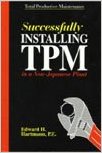 |
| 7 Habits of Highly Effective People by Stephen Covey
This twenty-fifth anniversary edition of Stephen Covey’s cherished classic commemorates the timeless wisdom of the 7 Habits. One of the most inspiring and impactful books ever written, The 7 Habits of Highly Effective People has captivated readers for 25 years. It has transformed the lives of Presidents and CEOs, educators and parents— in short, millions of people of all ages and occupations. |
Successfully Implementing TPM by Edward Hartmann |
Terry Wireman
|
 |
| Computerized Maintenance Management Systems by Terry Wireman
Provides the information needed to successfully evaluate, select and implement a system. Enables readers unfamiliar with the earlier book to discover how progressive companies are using computer programs to achieve cost reduction and control the maintenance of any facility. |
Benchmarking Best Practices for Maintenance, Reliability and Asset Management, Third Edition Updated to account for ISO 55000, Benchmarking Best Practices for Maintenance, Reliability and Asset Management, Third Edition, now includes an overview of this seminal and long-awaited standard and identifies the specific points where ISO 55000 will impact maintenance and reliability. New graphics to enhance the text s main points have been added throughout. As with past editions, the third edition provides a logical, step-by-step methodology that will enable any company to properly benchmark its maintenance function. It presents an overview of the benchmarking process, a detailed form for surveying and grading maintenance management, and a database of the results of more than 100 companies that have used this survey. Widely used, Benchmarking Best Practices for Maintenance, Reliability and Asset Management, Third Edition, has proven to be an invaluable planning guide and on-the-job reference for maintenance managers, plant engineers, operations managers, and plant managers. |
 |
 |
|
Total Productive Maintenance Second Edition by Terry Wireman Total Productive Maintenance Second Edition By Terry Wireman 2004, 224pp, illus., ISBN: 978-0-8311-0210-4, $46.95 Written for anyone who is considering implementing or currently using TPM or looking for ways of improving their current process, the second edition focuses on the financial approach to the subject-a methodology that produces quantifiable results allowing a TPM program to be sustainable. Completely revised and updated, this classic reference is the most flexible and comprehensive approach documented to date. Additionally, it offers a significant amount of new material, such as: 1. Various case studies that show how to explain the value of OEE to everyone in the organization from the senior executive to the shop floor personnel. 2. OEE discussions showing how to “dollarize” results and present the financial terms to executive financial personnel. 3. A clarification of the goals and objectives of TPM, allowing TPM Champions to clearly present a TPM business case to their organizations.4. The pitfalls that may be encountered during TPM implementation and how to avoid or correct these problems. |
Zero Breakdown Strategies by Terry Wireman This textbook is designed to assist companies, regardless of the type of industry or facility, to develop equipment management strategies, which when implemented, will virtually eliminate equipment malfunctions or breakdowns. This is important since companies today are incurring higher and higher levels of equipment downtime and lost efficiencies. This impacts the company s financial standing since they will try to compensate for their equipment problems by: 1. Investing in redundant equipment, increasing the asset base value and thus negatively impacting their profitability. 2. The lack of asset performance will reduce the capacity of the equipment, reducing the company s ability to provide its product or service at the design capability of the equipment. This reduction in the output of the equipment will reduce the income generated (Return on Assets), thus negatively impacting their profitability. The solution to the above problems is to focus on optimizing the utilization of the assets by implementation of strategies to eliminate all equipment breakdowns. In reality, whether a function loss or a function reduction breakdown, all breakdowns impact a company financially. Zero breakdown strategies are designed to provide cost effective solutions to equipment problems that will allow companies to realize the maximum return on investment in their assets. |
 |
 |
| Developing Performance Indicators for Managing Maintenance Second Edition by Terry Wireman
Developing Performance Indicators for Managing Maintenance is designed to provide the key details on how to measure and improve one of the most important functions in an organization today: Equipment or Asset Maintenance Management. As one of only a handful of comprehensive collections of performance indicators for managing maintenance in print today, this book is distinguished by its use of techniques based on a variety of management measurement systems, such as the Balanced Scorecard approach. While the previous edition primarily concentrated on the basic indicators for managing maintenance and how to link them to a company’s financials, this new edition goes further by also addressing recent advancements in the management of maintenance. This book is an invaluable tool for any company that wants to effectively measure and manage the entire spectrum of maintenance activities to help achieve competitive advantage. Such companies view maintenance as a way to reduce costs of producing their product or providing their services and are intent on using this cost advantage to lower prices, improve profit margins, and improve shareholder value. |
Benchmarking Best Practices in Maintenance Management by Terry Wireman Thoroughly revised and updated, this best selling book presents a logical, step-by-step methodology that will enable any company to conduct a cost-effective benchmarking effort. It presents an overview of the benchmarking process, a detailed form for surveying and “grading” maintenance management, and a database of the results of more than 100 companies that have used this survey. |
Reliabilityweb.com Certified Reliability Leader Complete Body of Knowledge
CRL Exam. Certified Reliability Leader Complete Body of Knowledge – The Association for Maintenance Professionals (AMP) has developed an exam and certification based on the Uptime Elements and it s Reliability Leadership system. Designed to create leaders who focus on delivering value to the triple bottom line of: Economic prosperity Environmental sustainability Social responsibility The body of knowledge that creates the foundation for the exam and certification includes: 1) Certified Reliability Leader Travel Guide: Reliability Leadership 2) Certified Reliability Leader Uptime Elements Passport Series(29 passports) 3) The (New) Asset Management Handbook: A Guide to ISO5500 4) Don t Just Fix it, Improve It! by Winston Ledet, Winston J. Ledet and Sherri Abshire 5) Level 5 Leadership at Work by Winston Ledet, Michelle Ledet Henley and Sherri Abshire 6) People: A Reliability Success Story by Cliff Williams 7) Clean, Green & Reliable A Sustainable Reliability Guide for Industrial Plants by Douglas Plucknette and Chris Colson.
Purchase the entire body of knowledge from Amazon.com
 |
 |
| Don’t Just Fix It, Improve It! A Journey to the Precision Domain by Winston Ledet
In this first installment of the Heroic Change series, James Emery is struggling with balancing his various roles as husband, father, and plant manager for Modern Products Manufacturing. When an accident occurs at the plant, leaving people seriously injured, James feels responsible. He is faced with his own inner demons as the incident brings back memories of a devastating accident that haunts his past. The accident is the impetuous to drastic changes in both James’ personal life and also his career. He embarks on a difficult journey of Heroic Change, likening the journey to the Holmes poem he admires in which the chambered nautilus, in its silent toil as the spiral grows, leaves the past for the new. James faces a long road of mistakes and missteps while facing opposition from his subordinates and pressure from his superiors. In his relentless pursuit to create lasting change, James gathers allies by building a shadow network of employees who support his plan for change. James fights to gain respect for his out of the box thinking, while trying to hold his family together as he spends long hours at work. More importantly, he fights to create a safe place for employees to work while satisfying his superiors with improved performance. James’ struggle is not unlike the mysterious life and death of the nautilus. He uses the nautilus, as well as a shield, as symbols to provide him with inspiration for his own life and spiritual growth as he travels the path to lasting Heroic Change. Don’t Just Fix It, Improve It is a very easy read because it is told as a story. It is also a good reminder of why you can’t just focus on planning and scheduling. The really good performers eliminate the defects before they ever turn into work orders. Small problems are seldom left to turn into big failures and big problems rarely happen. The authors hit the nail on the head when they demonstrate through the story that improvement efforts which simply focus on driving the right maintenance work practices bog the organization down with too much work and seldom succeed. Only after building in the defect elimination culture and reducing the defects coming into the system can the organization achieve the best practice benchmarks. The small problems don’t clog the CMMS system and the work processes can focus on the big issues. Small problems are taken care of immediately at the source. |
Level 5 – Leadership at Work (Heroic Change Book 2) by Winston Ledet
James Emery continues his Heroic Change journey in this second installment of the Heroic Change series. Due to his staggering success in improving the Modern Products Manufacturing Atlanta site, James has recently been promoted to Reliability Champion at its corporate offices. James has specifically been tasked with improving each of the Modern Products Manufacturing sites. Throughout the journey, James faces site managers who resent his interference in managing their own sites, site managers who appreciate the help but lack the skills of leadership, and other obstacles that threaten to derail his hopes of a successful company-wide change effort in which his own career success is depending upon. James faces conflicting emotions, seemingly insurmountable obstacles, and the impossible challenges of balancing family and work, managers versus leaders, and profitability versus safety in both his personal and professional journey. Will the Atlanta site continue to improve and sustain the change? Or will Atlanta regress while James’ attention is focused on the other sites? Will James be successful in his company-wide change effort? All of these questions and more will be revealed in this heartfelt journey to discovering how Level 5 Leadership at Work can guide an entire organization into truly lasting Heroic Change |
 |
 |
| Certified Reliability Leader Travel Guide: Reliability Leadership
The Reliability Leadership Travel Guide: Reliability Leadership is designed to empower you and your team on a self-led journey that will unlock extraordinary value for your organization. The Association for Maintenance Professionals (AMP) has developed an exam and certification based on the Uptime Elements and it’s Reliability Leadership system. This Travel Guide is a component of the Certified Reliability Leadership’s Body of Knowledge. |
Certified Reliability Leader Uptime Elements Passport Series
Uptime Elements Passport Series – The complete (29) Elements Collection and The Reliability Leadership Travel Guide are part of a holistic system based approach to reliability that includes: Technical Elements, Cultural Elements and Leadership Elements. The Uptime Elements Passport Series and The Reliability Leadership Travel Guide are components of the Certified Reliability Leadership’s Body of Knowledge. The Uptime Elements Passport Series includes: 1) Certified Reliability Leader Travel Guide: Reliability Leadership 2) Certified Reliability Leader Uptime Elements Passports (29) |
 |
 |
| The New Asset Management Handbook
If an asset is something that has actual or potential value to an organization, then this book is an asset to you and your organization. Some of the same people who shaped ISO55000, the current international asset management standard, share their knowledge and experience in this book. The aim of this work is to create a new way of thinking about how your organization manages its assets. Traditionally, the assets themselves directed reactive decisions at all levels of an organization based on the latest data or incident. Business analysts agree that reactive asset management decisions are usually not financially optimized. The simple translation is that there is tremendous opportunity for meeting the triple bottom line of financial opportunity, environmental sustainability and social responsibility through asset management. The asset management approaches expressed in the New Asset Management Handbook are designed to connect top management to the physical asset base using a concept called line of sight. Asset management frameworks require that value and acceptable risk be defined and understood at all levels of the organization. This provides the alignment in decision-making at all levels of the organization to deliver value from assets at an acceptable risk level.The revised edition of this handbook has divided the text into topic sections so the reader has a clearer understanding and focus. The sections are: Introduction, Line of Sight (alignment), Derived Value and Financial Impact, Asset Management Enablers,and Case Study |
People: A Reliability Success Story by Cliff Williams Bob Edwards inherited a totally reactive maintenance group and he’d been asked to make the plant more reliable. Join him as he moves towards World Class, using the best tools available to him – people. In this book, you will learn how empowering and engaging garners the collective strength and how listening becomes a key skill. |
Buy It on Amazon This book depicts the life and struggles of maintenance in seeking better ways and means in improving how to manage and maintain their equipment and assets. The Author shares his passion and experience about the day to day struggles in the life of a maintenance. Some of the main highlights of this book includes:
This book contains real life stories, struggles and actual experiences by the Author in his career in maintenance and currently as a Reliability and Maintenance Consultant. The book is easy to absorb as it is structured into three parts which are the Basics, the Strategies and the Advance Disciplines. The Twelve Disciplines are grouped accordingly into these three parts. Maintenance often time seek for advance ways in dealing with their everyday problems and issues. The message of this book is simple and straightforward, that there is no better way to start by going back to the “Basics” and addressing these very small problems we have in our plant. Big problems, unplanned break-downs and catastrophic failures are just an accumulation of small problems that has always been ignored and mostly neglected in the first place. The Author strongly emphasize the importance operators play in addressing these basic equipment condition and is considered a partner with maintenance on this shared responsibility they have towards their equipment. It is very difficult or impossible for maintenance people to transcend from a reactive to a proactive mode if operators will not be involved along the way. When the Basics had been set and well established, then maintenance can move on with the different maintenance and reliability strategies which are explained in detail on this book. Each Chapter covers a specific maintenance discipline. Chapter 14 of this book covers an implementation stage and the last chapter explains about people.
|
Buy it on Amazon This book depicts the life and struggle of maintenance in seeking better ways and means to improve the reliability of the equipment and assets. The author shares his experience on how to achieve such feat. Transitioning from a reactive to a proactive maintenance stage is not an easy tasks but it is not also an impossible tasks. What the author believes is that the key to everything is educating the maintenance people on what maintenance is all about. Training is where we acquire knowledge to develop the skills required to do our job right. This book contains real life stories, struggles and actual experiences by the author in his career in maintenance and currently as a Reliability and Maintenance Consultant. Every industry must change their paradigm and realize that maintenance are not repair people. The meaning of the word maintain is simply to preserve our equipment and assets. And we can only preserve our assets if maintenance are equipped with the right knowledge on how to perform their jobs right the first time around. I have written this book in order to reach out to industries in search of discovering ways to improve not only their equipment and assets but as well as their maintenance human resources. Remember that maintenance is not a department, it is not a function or any organization but rather maintenance are humble and down to earth human being, hence let us provide them with the respect that they truly deserve because that is all they ask for. The message of this book is simple and straightforward. There is no better way to start the journey to reliability other than to go back to the basics and addressing these very small problems we have in our plant. Big problems, unplanned breakdowns and catastrophic failures are just an accumulation of small problems that has always been ignored in the first place. Maintenance is always a shared responsibility for operators and maintenance working together in complete harmony. It will be difficult for maintenance to transition from a reactive to a proactive mode if operators will not be involved in doing maintenance since maintenance is always a shared responsibility for operators and maintenance This book explains in detail on how to proceed with the 4 Phases of Planned Maintenance and how to integrate RCM into the TPM process. It also covers the importance of doing Autonomous Maintenance as well as Spare Parts Management which is believed to be the missing link theory on any reliability and maintenance strategy. Chapter 11 is a classic case study on what maintenance can achieve if there is a clear roadmap to follow. The last chapter states that maintenance are just human like you and me. What is important is not to blame them for every single failure that occur in the plant but for both operations and maintenance to work together on the problem. Many industries are looking for a structured and detailed approach on how they can improve their maintenance asset and resources. This book provide that level of information. Each chapter begins with a quote on wisdom of maintenance and at the end of each chapter will be a quiz for you to answer. |

